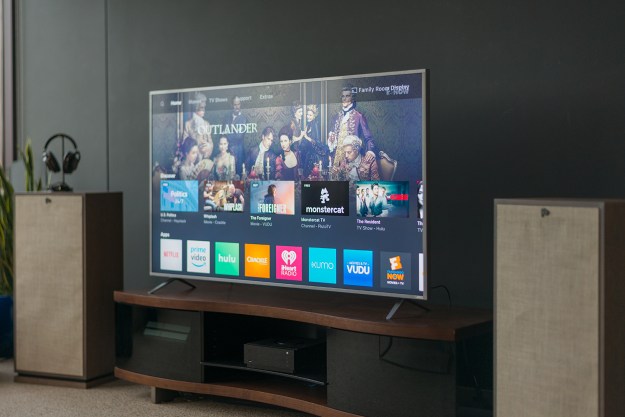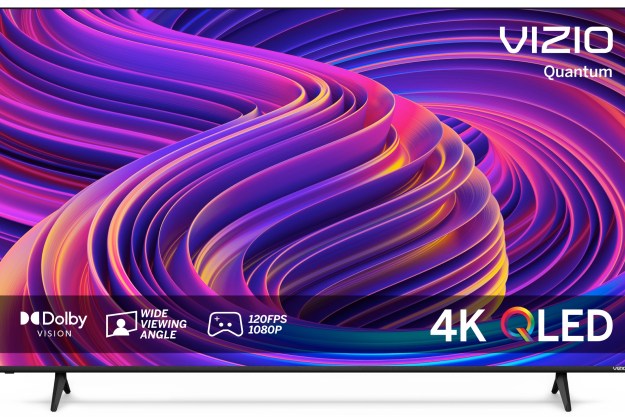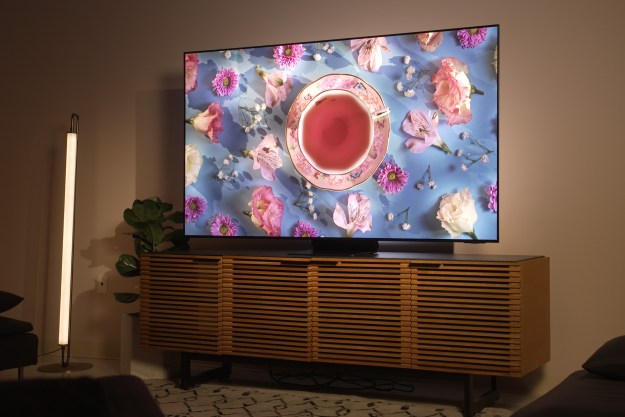
- Excellent contrast
- Accurate, vivid colors
- Impressive black levels
- Sleek and sexy design
- Great use of HDR10 and Dolby Vision
- No TV tuner
- Mediocre off-angle picture
- SmartCast interface just OK
Vizio P-Series Models
- While we reviewed the 65-inch P65-E1 model, our review applies to all P-Series TVs
- 55-inch (P55-E1)
- 65-inch (P65-E1)
Ever since the holidays came and went – your living room still sadly bereft of a beautiful new big-screen — you’ve been jonesing for a spanking new, HDR-packing, 4K TV. But if you’re not interested in plunking down the kind of cash it takes to land the big kahunas from the likes of LG, Samsung, and Sony, your craving is going to drive you headlong into the value king that is Vizio.
Vizio’s P-Series displays offer an intriguing proposition. Serious, high-end picture quality in a massive screen, available at a very reasonable price (as low as $1,300 for a 65-inch big boy). The question is, of course, can the P-Series deliver the goods?
While not a perfect 10, Vizio’s P-Series offers a gorgeous display of big-screen real estate that will supe up your living room and get your 4K motor humming.
Out of the box
As you might imagine, at first glance the P-Series looks almost identical to its peers in Vizio’s lineup (including the M-series and E-series displays we reviewed). But pulling the foam sheath away from its stout frame reveals a definite step up in style. Sexy in silver, the P-Series is arguably the best-looking TV in its class, offering a relatively slim bezel, chic and rounded foot stands to hold the unit together, and an overall frame that’s thinner than you’d expect from a full array-backlit LCD/LED TV.
Encased in foam at the bottom of the package is a UPS-brown box of accessories, including a slim-and-basic wand remote, an HDMI cable, a power cable, and a setup guide.
Features and design
As discussed in our other reviews of Vizio’s 2017 lineup, there’s a reason we keep calling the P-Series a “display.” Namely, these bad boys aren’t technically TVs because Vizio declines to install an over-the-air tuner found in virtually all other TVs on the market. It’s not a huge deal for those connecting a cable or satellite DVR system via HDMI, but cord cutters leveraging an HDTV antenna to get their live TV fix will need to buy an outboard TV tuner to get things connected. They’re not pricey, but it is one more step, and one more HDMI slot in use, which normally would have been accounted for with a basic coaxial input.
Luckily, the P-Series has an impressive number of HDMI inputs — five in all — and unlike its siblings, four of the five support HDR content (via HDMI 2.0a), meaning you can connect your 4K HDR gaming console,
Like the M-series (and E-series), Vizio’s P-Series offers full-array backlighting with local dimming (called Xtreme Black Engine Plus) to provide superior brightness over edge-lit TVs. Yet, while the M-series does pretty well with its 32-zone backlighting (actually a step down from the previous year), the P-Series packs a whopping 128 zones inside. That may just sound like a big number, but the more zones, the more effective a TV’s local dimming system is. This translates into darker blacks and fluent contrast control across the entire screen as light and dark objects interact. What that means for viewers is a richer, more dimensional picture, less haloing around bright objects on dark backgrounds, and better details in darker scenes.
In fact, thanks to Vizio’s Calibrated and Calibrated Dark Picture settings (we recommend the former for most environments), the P-Series looks excellent right out of the box. While serious videophiles may want to get more granular with the calibration, we made only a small tweak to the color setting, raising it by a few points, to get things locked in.
The P-Series offers HDR support for both Dolby Vision and HDR10, the two biggest players in HDR at present, which helps provide better contrast and richer color shading for supported content. But the P-Series also offers much higher peak brightness than the M-series (more on that in the Performance section). As Vizio pointed out, Wide Color Gamut is automatically available with or without engaging the UHD Color setting. In order to access full 60 fps
Not-so SmartCast
We’ve made no bones about being less than enthusiastic about Vizio’s latest iteration of its SmartCast interface, an amalgamation of built-in Chromecast streaming and a very slim selection of on-board apps. The user experience just isn’t as intuitive as what you get from from LG and Samsung televisions. Just getting to the right input can be a hassle, as Vizio TVs don’t skip over empty inputs and tend to switch to input options you may be trying to simply scroll by.
That said, Vizio’s system gets the job done, and it’s certainly zippy — especially for initial setup, which takes just minutes (barring any firmware updates).
Using Chromecast streaming from your phone or tablet is an effective (if not always stable) way to stream all kinds of content on this Vizio display, and most importantly, Vizio’s on-board app selection includes Amazon’s Prime Video, which is currently not supported by rival Google’s Chromecast system.
Performance
Any quibbles we have with SmartCast are small potatoes after seeing the P-Series in action. Frankly, the P-Series’ picture quality is an impressive testament to Vizio’s engineering might, offering rich and dimensional contrast, ultra-clear resolution to the finest pinpoints on-screen, and a rushing collage of colors that will have you staring into the subtlest details of your favorite movies — to the point that it’s easy to lose the strands of the plot.
We knew right from the Sovereign throne room in Guardians of the Galaxy Volume 2 that the P-Series was special. The iconic background shimmers in yellow light, with subtle variants of metallic blue and deep, sparkling golds, while the queen’s yellow eyes dart around in striking detail.
There are plenty of details that draw your eyes with the P-Series, but the subtleties of the color reproduction continued to be one of our favorite traits. Deadpool’s intro scene wasn’t just a carnival of carnage, but a chance to marvel at the excellent Blu-ray transfer, allowing for nuances to shine through like the different shades of nickel and brass on Colossuss’ circlets of armor, or the worn shoulder pads of Pool’s uniform, which are more distressed at the edges to reveal little glints of white.
The brilliant picture quality is a testament to Vizio’s engineering might.
The P-Series’ impressive contrast helps make all the colors pop, while also adding deep dimension to the picture. In addition, the display offers impressive black levels and details in darker scenes, even in challenging moments like The Martian’s deep space shots. Speaking of The Martian, it offers one of our favorite telltale scenes for testing, in which a search light sweeps around the top of the hab in the Martian twilight. We’ve seen lesser TVs lose virtually all surrounding details to black clipping there, smearing the craggy peaks, but with the P-Series we could see the entire landscape of rock and sand surrounding Watney’s deep-space prison.
The TV does have a few blind spots, as it were, including poor off-axis color reproduction and contrast (something we’re getting tired of complaining about with LCD displays), though it’s perhaps a bit less notable than the M-series, and definitely outperforms the E-series there. We also noticed a bit of image flicker in a couple of outlying scenes, including a panning shot of trees from Planet Earth 2 in which the TV’s processor seemed to get confused by all the leaves, creating a strobing effect. However, it was relegated to just a few select moments, and not something that put a damper on our experience.
When it comes to HDR, the P-Series isn’t as piercingly bright as top-tier LCD displays from Samsung or Sony, but its 600-nit average brightness outshines the M-series, and the TV can get “much brighter” in spectral highlights, according to Vizio. It’s not something that’s incredibly notable on its own, but the display’s ability to offer more sparkle in extremely bright details such as the flash of lip gloss or the beads of sweat on a closeup of a character’s face combined with the display’s impressive contrast add up to a highly dimensional picture that’s extremely captivating.
Warranty information
Vizio warranties its P-Series TV for one year for “defects in materials and workmanship” when the product is used in normal conditions. You can find out more by visiting the website.
Our Take
While all of Vizio’s SmartCast displays offer impressive picture quality, the P-Series is the nexus at which affordability and high performance meet for an incredible value.
Is there a better alternative?
The first TV that comes to mind is Vizio’s own M-series, but when you consider that the P-Series offers better contrast, higher peak brightness, and overall better performance for just a few hundred dollars more, this is one case in which it just makes more sense to spend that extra cash and go for broke.
TCL also makes a pretty impressive TV in this general price class in its own (confusingly named) P-Series, which also offers an intuitive Roku-based interface. But those who want a larger screen (above 55-inches) can’t get it from TCL until Spring of 2018, and Vizio’s version still offers better overall performance for our money.
How long will it last?
As a budget brand, there are always some considerations about durability over time, but the P-Series feels well-built and Vizio is a massive brand with a good reputation in the industry.
Should you buy it?
Yes. When it comes to excellent picture quality at a killer price, this is the TV to buy.
Editors' Recommendations
- Best Vizio TV deals: Cheap smart TVs starting at $90
- Best QLED TV deals: Samsung, TCL, LG and Vizio
- Best 65-inch TV deals: Get a 65-inch 4K TV for under $400
- The best 4K TVs under $500: premium picture on a budget
- 1080p vs 1080i: What’s the difference?









